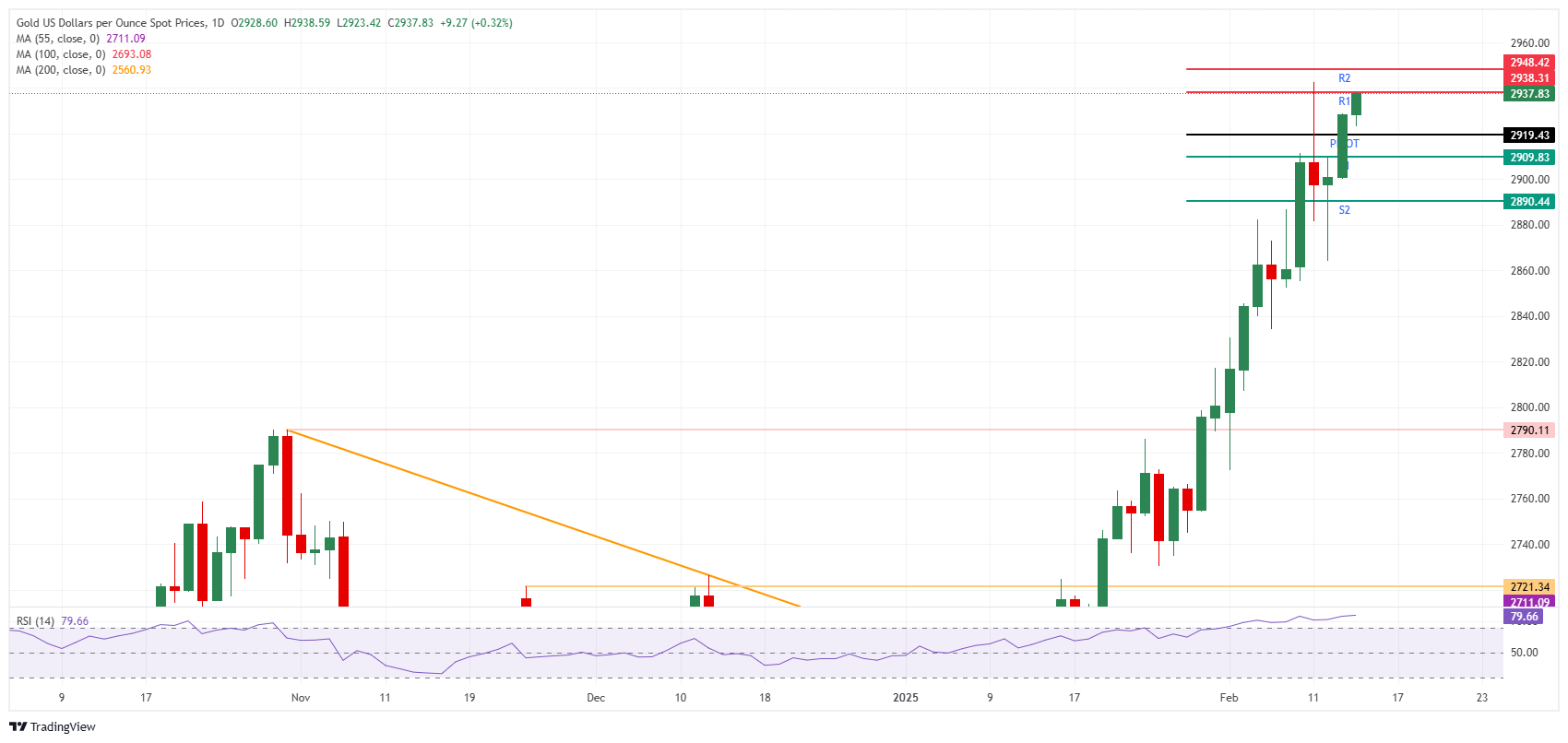Gold on its way to hit another fresh all-time high
- Gold nudges higher as US President Trump’s reciprocal tariffs are coming in a few weeks.
- Bullion is benefiting from safe-haven demand and a substantially weaker US Dollar.
- Gold is back on its way to test the all-time high at $2,942 on Friday.
Gold’s price (XAU/USD) edges higher, trading at around $2,935 at the time of writing on Friday, and holds good cards to close out this week with a new all-time high and solid gains. The latest leg up comes after United States (US) President Donald Trump signed the executive order for reciprocal tariffs on Thursday. Although it will still take weeks before tariffs are implemented, investors are not taking any chances and are parking their money in safe haven Gold.
Meanwhile, Gold added another tailwind to its rally, with a substantially weaker US Dollar (USD) and US Dollar Index (DXY) overall. The Greenback is losing traction because President Trump’s reciprocal tariffs need weeks or months before implementation. That opens the window of opportunity for negotiations, and hence, there is no immediate flight to a safe haven on the back of any announcement or signing of an executive order by the US President.
Daily digest market movers: Geopolitics take over
- Gold advances for a third day to trade near a record high after US President Donald Trump’s order for reciprocal tariffs against several nations increased uncertainty around trade and the global economy, Bloomberg reports.
- Bullion futures on Comex are trading at a substantial premium to spot. The most active contract is for April, and it is currently above $2,960. Meanwhile, cash is $30 lower, just below its all-time high, Reuters reports.
- At 13:30 GMT, January’s US Retail Sales data will be released. Expectations are for a 0.1% fall in Retail sales compared to the 0.4% increase in December.
Technical Analysis: What if
Gold is set to hit a fresh all-time high just before the weekend. If the trend continues, it will be tough to fight it. However, a positive shift in geopolitics could move the needle and no longer warrant a higher Gold price.
The first support level on Friday is $2,919, which is the daily Pivot Point. From there, S1 support stands at $2,909. Further down, the S2 support at $2,890 should act as a safeguard and prevent any additional declines to the more significant $2,790 level (October 31, 2024, high).
On the upside, the R1 resistance at $2,938 is the first level that needs to be recovered, followed by the R2 resistance at $2,948. In case the rally continues, the $2,950 big figure will be tested for a break to the upside. Further up, the $3,000 psychological level could be next.

XAU/USD: Daily Chart
Gold FAQs
Gold has played a key role in human’s history as it has been widely used as a store of value and medium of exchange. Currently, apart from its shine and usage for jewelry, the precious metal is widely seen as a safe-haven asset, meaning that it is considered a good investment during turbulent times. Gold is also widely seen as a hedge against inflation and against depreciating currencies as it doesn’t rely on any specific issuer or government.
Central banks are the biggest Gold holders. In their aim to support their currencies in turbulent times, central banks tend to diversify their reserves and buy Gold to improve the perceived strength of the economy and the currency. High Gold reserves can be a source of trust for a country’s solvency. Central banks added 1,136 tonnes of Gold worth around $70 billion to their reserves in 2022, according to data from the World Gold Council. This is the highest yearly purchase since records began. Central banks from emerging economies such as China, India and Turkey are quickly increasing their Gold reserves.
Gold has an inverse correlation with the US Dollar and US Treasuries, which are both major reserve and safe-haven assets. When the Dollar depreciates, Gold tends to rise, enabling investors and central banks to diversify their assets in turbulent times. Gold is also inversely correlated with risk assets. A rally in the stock market tends to weaken Gold price, while sell-offs in riskier markets tend to favor the precious metal.
The price can move due to a wide range of factors. Geopolitical instability or fears of a deep recession can quickly make Gold price escalate due to its safe-haven status. As a yield-less asset, Gold tends to rise with lower interest rates, while higher cost of money usually weighs down on the yellow metal. Still, most moves depend on how the US Dollar (USD) behaves as the asset is priced in dollars (XAU/USD). A strong Dollar tends to keep the price of Gold controlled, whereas a weaker Dollar is likely to push Gold prices up.

